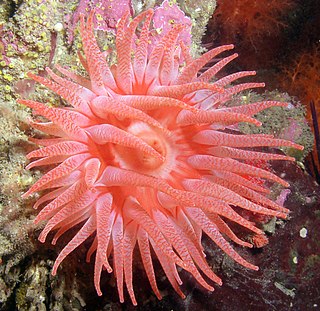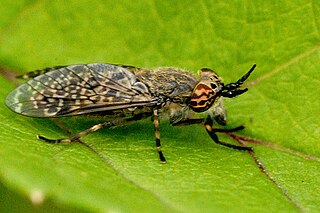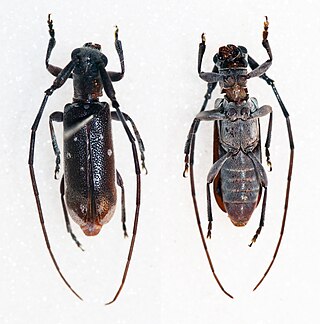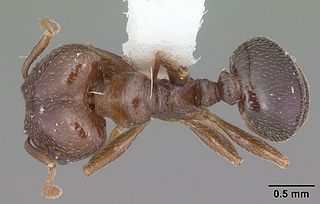
Hermissenda crassicornis, also known as the opalescent nudibranch or thick-horned nudibranch, is a species of brightly coloured, sea slug or nudibranch, a marine gastropod mollusc in the family Facelinidae.

Cribrinopsis fernaldi, also known as the crimson anemone, snakelock anemone, chevron-tentacle anemone and Fernald brooding anemone, is a sea anemone native to the Pacific Ocean off northwestern North America.

Urticina crassicornis, commonly known as the mottled anemone, the painted anemone or the Christmas anemone, is a large and common intertidal and subtidal species of sea anemone. Its habitat includes a large portion of the coastal areas of the northern hemisphere, mainly polar regions, and it lives a solitary life for up to 80 years. Mottled anemones are similar to Dahlia anemones and both are commonly referred to as northern red anemones.

Noterus crassicornis is a species of beetle native to the Palearctic and the Near East. In Europe, it is only found in Austria, Belarus, Belgium, Bosnia and Herzegovina, Bulgaria, Croatia, Cyprus, the Czech Republic, mainland Denmark, Estonia, European Turkey, Finland, mainland France, Germany, Great Britain including the Isle of Man, Hungary, the Republic of Ireland, mainland Italy, Latvia, Lithuania, Luxembourg, Moldova, Northern Ireland, North Macedonia, mainland Norway, Poland, Russia, Sicily, Slovakia, Slovenia, Sweden, the Netherlands, Ukraine and Yugoslavia.
Cydia crassicornis is a moth of the family Tortricidae. It was first described by Lord Walsingham in 1907. It is endemic to the island of Hawaii.

Hermissenda is a genus of sea slugs, aeolid nudibranchs, marine gastropod molluscs in the family Facelinidae.

Chamaesphecia crassicornis is a moth of the family Sesiidae. It is found in south-eastern Austria, southern Slovakia, Hungary, Serbia, Romania, Bulgaria, southern Russia, Kazakhstan and Kyrgyzstan. It is rare in central Europe. It has been released in North America for the biological control of leafy spurge.
Evagetes crassicornis is a kleptoparasitic spider wasp with a holarctic distribution.

Haematopota crassicornis, the black-horned cleg is a species in the horse-fly family, Tabanidae.

Acharya crassicornis is a moth of the family Erebidae first described by Frederic Moore in 1882. It is found in India.

Eunidiini is a tribe of longhorn beetles of the subfamily Lamiinae. It was described by Téocchi et al. in 2010.

Eunidia is a genus of longhorn beetles of the subfamily Lamiinae.
Hermissenda emurai is a species of brightly coloured sea slug or nudibranch, a marine gastropod mollusc in the family Facelinidae.
Eunidia batesi is a species of beetle in the family Cerambycidae. It was described by Olliff in 1889.

Eunidia thomseni is a species of beetle in the family Cerambycidae. It was described by William Lucas Distant in 1898. It is known from Tanzania, Cameroon, Chad, Niger, Ethiopia, Senegal, Mozambique, Botswana, Namibia, Saudi Arabia, the Central African Republic, Somalia, Uganda, South Africa, Yemen, Kenya, and Zimbabwe.

Tragocephala crassicornis is a species of beetle in the family Cerambycidae. It was described by Karl Jordan in 1903.
Glabellula crassicornis is a species of micro bee flies in the family Mythicomyiidae.

Pheidole crassicornis is an ant, a species of higher myrmicine in the family Formicidae.

Xestoleptura crassicornis is a species of flower longhorn in the beetle family Cerambycidae. It is found in North America.












